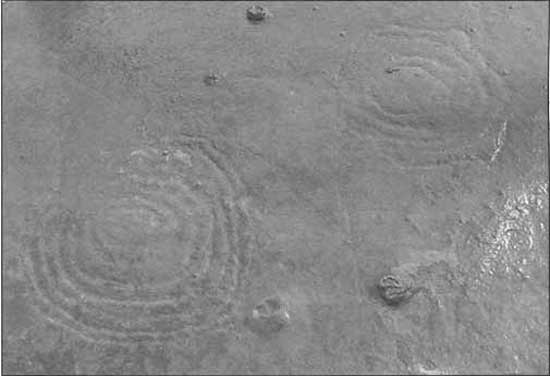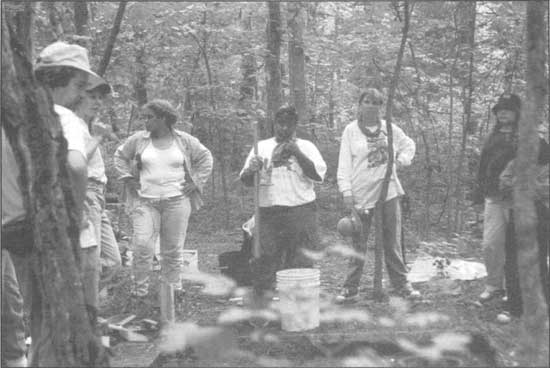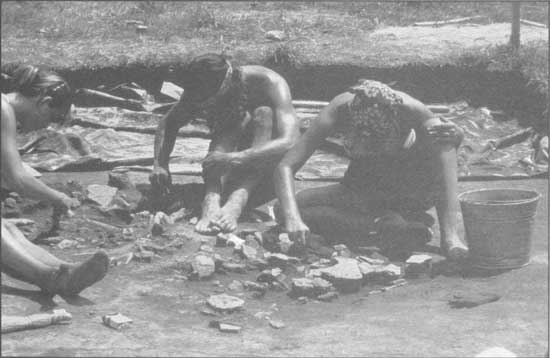Looking at Prehistory:
Indiana's Hoosier National Forest Region, 12,000 B.C. to 1650
|

|
Looking at Prehistory:
The Role of the Public in Archaeological Research
Prehistoric archaeology is the study of ancient human
lifeways and cultures that left no written record of their lives. We can
only know about them today through the study of the camps and villages
(archaeological sites) where they once lived, along with their artifacts
and preserved architectural remains that they left behind. Thus, it is
vital that these sites be properly recorded and the artifacts from them
documented. When artifacts are found such as bones, shells, pits with
charcoal and other things, they often represent the remains of an
ancient camp site or village. Archaeologists in the state are engaged in
a constant effort to record and protect these sites for the future, but
without the help of the public, much of it goes unreported
and eventually is destroyed by new housing subdivisions, businesses,
roads, bridges, coal mines, pot-hunting or looting (Figures
119-121).

|
|
Figure 119: The Slack Farm site in Kentucky seen from
the air. This site was the scene of heavy looting which led to arrests
and prosecution of several persons and upgrading of the laws protecting
archaeological sites in several states (Photo courtesy of Kenny Barkley;
from Pollack, Munson, and Henderson 1996).
|

|
|
Figure 120: Archaeologists work with Native Americans at Slack Farm
to assess the looting damage and make assessments of the overall damage
and loss of valuable history.
|

|
|
Figure 121: Graffiti damage on prehistoric mortars at Hemlock Cavern
Rockshelter.
|
Archaeological sites located in the Hoosier National
Forest are protected by federal law and should not be disturbed. If
artifacts or other archaeological remains are observed, please report
them to the forest archaeologist in Bedford, Indiana. Plot the location
on a USGS quadrangle map or other scaled map to pinpoint the location
where you made your discovery. The site can then be formally recorded
and authorities can locate and monitor the site. By doing this, you may
help save a site from destruction as it may be highly
significant for writing the story of the prehistory of the region
(Figures 122-124). Also, please report areas of disturbed earth within
the forest that could be the result of vandalism. The penalties for
looting are strict. Archaeological investigations, including
excavations, are only conducted under professional supervision and only
after obtaining a formal permit to do so.

|
|
Figure 122 (below): Circular images from the Roll Petroglyph site.
These petroglyphs (pecked images in rock) and others were recorded in
1998 and 2001. They were highly weathered and some were barely visible
because of river scouring.
|

|
|
Figure 123: Prehistoric images at the Roll Petroglyph site. These
are Late Prehistoric or Historic period images. Image H is commonly
interpreted to depict the bow and arrow based on rock art research in
other regions of the country.
|

|
|
Figure 124: A prehistoric pictograph (painting) on
the wall of Cedar Bluff Rockshelter. While this and others on the wall
are rudimentary, they capture the flow of movement and have character.
The one shown here probably depicts a warrior wearing feathers with a
shield in one hand and a club or battle ax in the other. It may also be
the case that some of the detail was lost to weathering and the use of
an atlatl or the killing of an animal or evil spirit cannot be ruled
out. The age is unknown, but a later prehistoric time frame is
suggested. The art medium is black in color and probably a mixture of
several unknown substances.
|
Archaeological research is regularly conducted in all
parts of the state of Indiana by archaeologists connected with the
various universities, the Hoosier National Forest, the Department of
Natural Resources, and private Cultural Resource Management
offices (see listing of offices and organizations below). You can
participate in field research by making contact with local
archaeologists (Figure 125). Archaeological field schools are conducted
each summer by many of the universities which offer solid training in
archaeological techniques and theory while granting college credit
(Figure 126). There are also a number of avocational archaeological
groups in the state that are devoted to proper collecting and recording
of archaeological sites and welcome new
members. Members of these groups are often able to
help with salvage excavations of endangered archaeological sites, assist
in the recording of accidental discoveries, and participate in grant
funded archaeological research.

|
|
Figure 125 (below): Volunteers taking a break while helping
archaeologists with an excavation.
|

|
|
Figure 126: Students hard at work in the heat of summer at Angel Mounds.
Indiana University field school, 1976.
|
The State Archaeologist's office in the Division of
Historic Preservation and Archaeology in Indianapolis is the main
clearinghouse for archaeological information in Indiana. That office
administers permits and grants for field investigations in all regions
of the state and has programs and literature on archaeological research.
They provide information on recording archaeological sites, identifying
artifacts, laws that protect archaeological sites (including human
burials and cemeteries) and much more. The State Archaeologist's
office also sponsors "Archaeology Month" each
September which provides an opportunity for professionals and
avocational archaeologists to work together to educate the public about
archaeology through the many programs and events they sponsor around the
state.
9/hoosier/prehistory/sec10.htm
Last Updated: 21-Nov-2008 |
|








